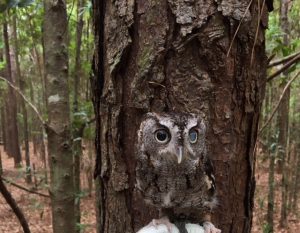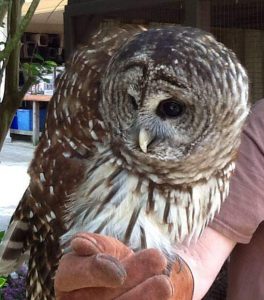Today’s wildlife topic is like some others we have discussed in other lessons… you might see it, you might not.
You might ask, why would I highlight a creature you might not see?
Well… because you might… and if you do, it is VERY cool!
We are talking about owls.

Photo: Molly O’Connor
There are owls living all around the Pensacola area. Most of the time I see them near water, particularly rivers. For those of you who live near one of our rivers, your chances of seeing (or hearing one) are greater. I have seen them near Santa Rosa Sound, and I live not far from Bayou Texar. They are here.
My wife and I like to sit on the back deck in the evenings. We watch stars and listen to what is going on around us. The Eastern Screech Owl has a call it makes that is pretty unique. Once you have heard it, you will know it, and you begin to notice the call when they make it. We have one living in our backyard… somewhere. We have not seen it, but we hear it most nights. Actually, more than one. I think it is living in the old oak tree that we have mentioned in other lessons, the one with the woodpeckers, and where the squirrels fight all of the time – but I am not sure.

Photo: Molly O’Connor
We usually hear the calls shortly after sunset. Maybe between 8:00 and 12:00 PM. One will sing, and another – nearby somewhere – sings back. This goes on for about an hour or so and then stops. But also hear them about an hour before sunrise. I usually get up at sunrise to write these articles. I like sunrise. Good time to see wildlife in the yard, and the owls are one of those I hear.
Eastern Screech owls are one of the smallest of the owls, reaching only about 10” tall. Their coloration is amazingly similar to the bark of local trees. So, even if one is sitting in front of you, they could be impossible to see.
One evening while we were sitting on the back porch, a very large bird flew directly over our heads. It was amazing in that (a) it was so large, and (b) it was so silent. It flew from the old oak tree to a group of laurel oaks on the other side of the yard. There, my wife and I saw it – a Great Horned Owl. These are one of the larger owls in our part of Florida – reaching 25”. It disappeared quickly but was VERY exciting to see. A few days later, I was sitting on our front porch at sunset and saw what looked like the silhouette of an owl sitting in a tall pine tree on the next block. I stared at it for several seconds to see whether the head would move, or something to confirm I was looking at a Great Horned Owl. It never budged. I looked away for a second to talk to someone and when I looked back, again on a few seconds, it was gone. It was definitely an owl. VERY cool.

Photo: Molly O’Connor
We do not see Great Horned Owls very often. We do hear them from time to time, but again, not very often. Just recently I was told of a nest of Great Horneds in Gulf Breeze. These owls like to utilize the empty nests of eagles and osprey when they are not using them. This one was at Shoreline Park South. If you park across from the dog park – walk south towards the water – you will find a concrete path that leads into the woods. Follow this for about 100 yards or so – look up to the right – and you should eventually find a nest in a tall dead tree. It had three baby owlets inside that were pretty old and, I think, about to take their first flight. They may be gone now, but, if you live nearby, take a look.
One other owl we know lives in our area is the Barred Owl. We have never seen one of these near our home. However, we have seen, and heard, them when paddling along one of our rivers. They seem to like it there and near swamps. These are big owls, reaching 24”, and have the classic “hoo… hoo cooks for you” call.

Photo: Molly O’Connor
Owls are amazing birds. Large bodies and large heads which act like radars seeking prey, such as rodents. Their large heads have two large eyes that can detect prey at night – their favorite time to hunt. They see at night the way we see at sunset. The two large eyes are set in front of their head, we call this binocular vision. Binocular vision provides excellent depth perception – the owl knows exactly how far away you are. However, binocular vision blocks the view behind you. You and I have this. We can see what is front of us… we know exactly where it is in space… but we cannot see behind us – (except mothers… all moms have x-ray vision like Superman, they see everything you are doing in the other room – but that is another lesson).
Most predators have binocular vision. They really do not care what is behind them. Owls are a bit different though, their eyes are fixed in the head. We can move our eyes while holding our head still, they cannot. BUT, they can turn their head almost 360°. If they want to know what is behind them, they can look! They cannot rotate it all the way around, as seen in some cartoons, but they can come close.
Then there are the ears. An owl sitting on a goal post of a football field can hear the heartbeat of a mouse sitting on the 50-yard line! For most owls, an ear opening on one side of the head is higher than the ear opening on the other. This increases their range of hearing. Their face is also depressed like a TV dish antenna. It collects sound and moves it towards the ear openings. The hearing of owls is incredible. By the way, the ear tufts (feathers that look like ears) are just feathers, not their ears.
Don’t know if you will ever see, or hear one, but I think it would be fun to look and listen. Maybe, just maybe, you will hear your yard.
ACTIVITY –
– First activity will be to better understand how binocular vision helps predators, like owls, zero in on where their prey is and nab it in flight. Pick an object in your house about 10-20’ away. Look directly at it. You can see it, and you know exactly where it is. Continue to look at it but this time cover your left eye. You can still see it. Point at it. You should be able to see your finger point directly at the object. Without moving your finger, open your left eye and cover your right eye. You should notice that your finger is no longer point at the object. If using monocular vision (one eye) you would probably miss your prey.
– Another activity that shows the same idea. Place a small cup on the counter. Stand back about 3’. Cover one eye. Have a friend hold a quarter about 6” above the cup and tell them when they are directly over the cup. When you think they are there, tell them to drop it and see if it falls in the cup. Usually it misses, but with both eyes open, you are able to get the coin on the cup each time.
– Listen to the call of the Eastern Screech Owl on the internet. Learn the sound and then tonight, after dark, listen and see if you have one nearby.
HAVE FUN AND STAY SAFE!
 0
0
